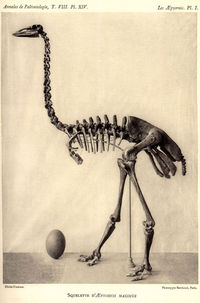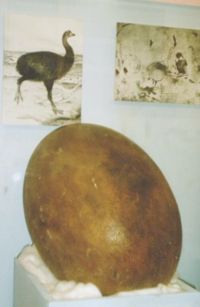Elephant birds
Conservation status Extinct (16th century) |

|
|
Scientific classification |
| Kingdom: |
Animalia
|
| Phylum: |
Chordata
|
| Class: |
Aves
|
| Superorder: |
Paleognathae
|
| Order: |
Struthioniformes
|
| Family: |
Aepyornithidae
|
|
|
Genera |
Aepyornis
Mullerornis |
Elephant birds are an
extinct family of flightless
birds made up of the genera Aepyornis and
Mullerornis. These large birds, which were native to
Madagascar, have been extinct since at least the 16th
century. Aepyornis was the world's largest bird, believed to
have been over three metres (10 feet) tall and weighing more
than half a tonne (500 kilograms, or 1,100 pounds), until
being dethroned by Phorusrhacidae in October 2006.
[1] Remains of Aepyornis adults and eggs have
been found; in some cases the eggs have a circumference of
over one metre (three feet). Four species are usually
accepted in the genus Aepyornis today; A.
hildebrandti, A. gracilis, A. medius and A. maximus
(Brodkorb, 1963), but the validity of some is disputed, with
numerous authors treating them all in just one species,
A. maximus. Aepyornis was a
ratite, related to the
ostrich; it could not fly, and its breast bone had no
keel.
The
National Geographic Society in Washington holds a specimen
of an Aepyornis egg which was discovered by Luis Marden in
1967. The specimen is intact and contains an embryonic
skeleton of the unborn bird.
Whilst it is often believed that the extinction of the
Aepyornis was an effect of human actions, a study in
2000, by a team of archaeologists from Sheffield University
and Royal Holloway University in the UK, suggests otherwise. Their study in Madagascar aimed
to investigate human relationships with this bird. Research
reports from Sheffield University stated that there was no
evidence for the suggestion that the bird had been hunted to
extinction. The archaeologists also believe that the killing
of the bird may have been taboo, or "fady," as no evidence
was found that it had been killed for food.
The modern
Malagasy name for the bird is Vorompatra, meaning
"marsh bird". They are commonly known as the 'elephant
bird', a term that originated from
Marco Polo. It has also been suggested, (compare text on the
Fra Mauro map of 1467-69) that the legend of the roc
may have originated from this bird.

Reconstruction of Elephant Bird Egg, Ipswich
Museum, England
Elephant Bird Species
- Aepyornis gracilis (Monnier, 1913)
Aepyornis hildebrandti (Burckhardt, 1893)
Aepyornis maximus (Geoffroy-Saint Hilaire, 1851)
Aepyornis medius (Milne-Edwards & Grandidier, 1866)
Mullerornis betsilei (Milne-Edwards & Grandidier, 1894)
Mullerornis agilis (Milne-Edwards & Grandidier, 1894)
Mullerornis rudis (Milne-Edwards & Grandidier, 1894)
In literature
-
H.G. Wells wrote a short story entitled Aepyornis Island
about the bird. It was published in The Complete Short
Stories of H.G. Wells (ISBN 0-7538-0872-2).
Full text.
References
- Brodkorb, Pierce (1963): Catalogue of Fossil Birds
Part 1 (Archaeopterygiformes through Ardeiformes).
Bulletin of the Florida State Museum, Biological
Sciences 7(4): 179-293.
PDF fulltext
Gallery
Aepyornis




